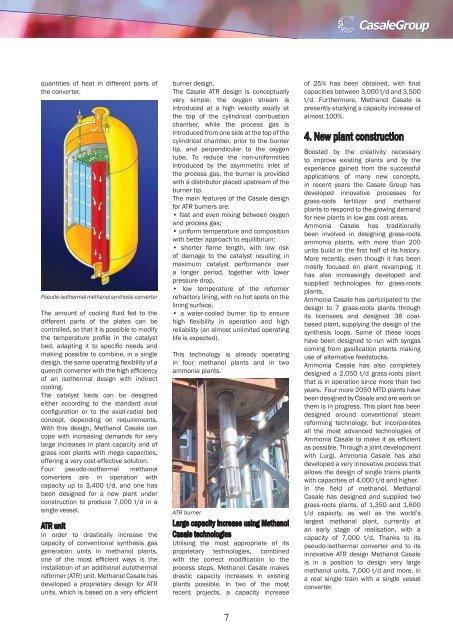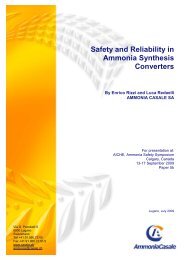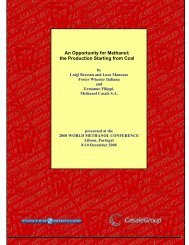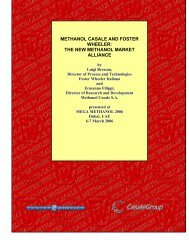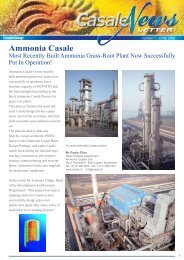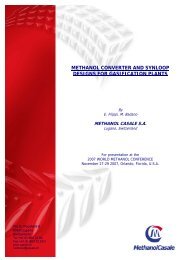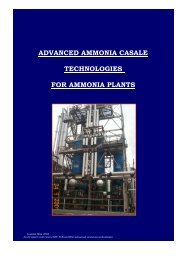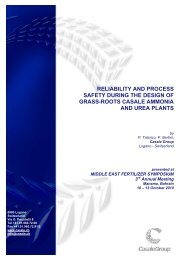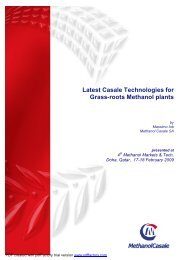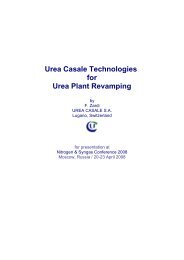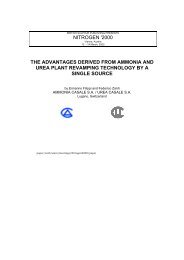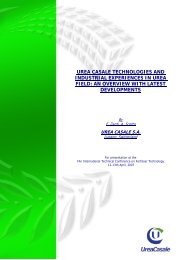The most Advanced Technologies for ... - CASALE GROUP
The most Advanced Technologies for ... - CASALE GROUP
The most Advanced Technologies for ... - CASALE GROUP
Create successful ePaper yourself
Turn your PDF publications into a flip-book with our unique Google optimized e-Paper software.
quantities of heat in different parts of<br />
the converter.<br />
Pseudo-isothermal methanol synthesis converter<br />
<strong>The</strong> amount of cooling fl uid fed to the<br />
different parts of the plates can be<br />
controlled, so that it is possible to modify<br />
the temperature profi le in the catalyst<br />
bed, adapting it to specifi c needs and<br />
making possible to combine, in a single<br />
design, the same operating fl exibility of a<br />
quench converter with the high effi ciency<br />
of an isothermal design with indirect<br />
cooling.<br />
<strong>The</strong> catalyst beds can be designed<br />
either according to the standard axial<br />
confi guration or to the axial-radial bed<br />
concept, depending on requirements.<br />
With this design, Methanol Casale can<br />
cope with increasing demands <strong>for</strong> very<br />
large increases in plant capacity and of<br />
grass root plants with mega capacities,<br />
offering a very cost-effective solution.<br />
Four pseudo-isothermal methanol<br />
converters are in operation with<br />
capacity up to 3,400 t/d, and one has<br />
been designed <strong>for</strong> a new plant under<br />
construction to produce 7,000 t/d in a<br />
single vessel.<br />
ATR unit<br />
In order to drastically increase the<br />
capacity of conventional synthesis gas<br />
generation units in methanol plants,<br />
one of the <strong>most</strong> effi cient ways is the<br />
installation of an additional autothermal<br />
re<strong>for</strong>mer (ATR) unit. Methanol Casale has<br />
developed a proprietary design <strong>for</strong> ATR<br />
units, which is based on a very effi cient<br />
burner design.<br />
<strong>The</strong> Casale ATR design is conceptually<br />
very simple: the oxygen stream is<br />
introduced at a high velocity axially at<br />
the top of the cylindrical combustion<br />
chamber, while the process gas is<br />
introduced from one side at the top of the<br />
cylindrical chamber, prior to the burner<br />
tip, and perpendicular to the oxygen<br />
tube. To reduce the non-uni<strong>for</strong>mities<br />
introduced by the asymmetric inlet of<br />
the process gas, the burner is provided<br />
with a distributor placed upstream of the<br />
burner tip.<br />
<strong>The</strong> main features of the Casale design<br />
<strong>for</strong> ATR burners are:<br />
• fast and even mixing between oxygen<br />
and process gas;<br />
• uni<strong>for</strong>m temperature and composition<br />
with better approach to equilibrium;<br />
• shorter fl ame length, with low risk<br />
of damage to the catalyst resulting in<br />
maximum catalyst per<strong>for</strong>mance over<br />
a longer period, together with lower<br />
pressure drop.<br />
• low temperature of the re<strong>for</strong>mer<br />
refractory lining, with no hot spots on the<br />
lining surface.<br />
• a water-cooled burner tip to ensure<br />
high fl exibility in operation and high<br />
reliability (an al<strong>most</strong> unlimited operating<br />
life is expected).<br />
This technology is already operating<br />
in four methanol plants and in two<br />
ammonia plants.<br />
ATR burner<br />
Large capacity increase using Methanol<br />
Casale technologies<br />
Utilising the <strong>most</strong> appropriate of its<br />
proprietary technologies, combined<br />
with the correct modifi cation to the<br />
process steps, Methanol Casale makes<br />
drastic capacity increases in existing<br />
plants possible. In two of the <strong>most</strong><br />
recent projects, a capacity increase<br />
7<br />
of 25% has been obtained, with fi nal<br />
capacities between 3,000 t/d and 3,500<br />
t/d. Furthermore, Methanol Casale is<br />
presently studying a capacity increase of<br />
al<strong>most</strong> 100%.<br />
4. New plant construction<br />
Boosted by the creativity necessary<br />
to improve existing plants and by the<br />
experience gained from the successful<br />
applications of many new concepts,<br />
in recent years the Casale Group has<br />
developed innovative processes <strong>for</strong><br />
grass-roots fertilizer and methanol<br />
plants to respond to the growing demand<br />
<strong>for</strong> new plants in low gas cost areas.<br />
Ammonia Casale has traditionally<br />
been involved in designing grass-roots<br />
ammonia plants, with more than 200<br />
units build in the fi rst half of its history.<br />
More recently, even though it has been<br />
<strong>most</strong>ly focused on plant revamping, it<br />
has also increasingly developed and<br />
supplied technologies <strong>for</strong> grass-roots<br />
plants.<br />
Ammonia Casale has participated to the<br />
design to 7 grass-roots plants through<br />
its licensees and designed 36 coalbased<br />
plant, supplying the design of the<br />
synthesis loops. Some of these loops<br />
have been designed to run with syngas<br />
coming from gasifi cation plants making<br />
use of alternative feedstocks.<br />
Ammonia Casale has also completely<br />
designed a 2,050 t/d grass-roots plant<br />
that is in operation since more than two<br />
years. Four more 2050 MTD plants have<br />
been designed by Casale and are work on<br />
them is in progress. This plant has been<br />
designed around conventional steam<br />
re<strong>for</strong>ming technology, but incorporates<br />
all the <strong>most</strong> advanced technologies of<br />
Ammonia Casale to make it as effi cient<br />
as possible. Through a joint development<br />
with Lurgi, Ammonia Casale has also<br />
developed a very innovative process that<br />
allows the design of single trains plants<br />
with capacities of 4,000 t/d and higher.<br />
In the fi eld of methanol, Methanol<br />
Casale has designed and supplied two<br />
grass-roots plants, of 1,350 and 1,600<br />
t/d capacity, as well as the world’s<br />
largest methanol plant, currently at<br />
an early stage of realisation, with a<br />
capacity of 7,000 t/d. Thanks to its<br />
pseudo-isothermal converter and to its<br />
innovative ATR design Methanol Casale<br />
is in a position to design very large<br />
methanol units, 7,000 t/d and more, in<br />
a real single train with a single vessel<br />
converter.


